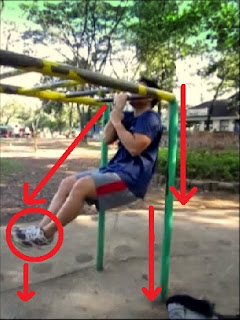Have you ever seen the last installment of the Rocky films? C’mon, I know you have. There’s one scene where Rocky wakes up early morning. He goes to his backyard while drinking coffee. Lo and behold, a pullup bar awaits at the back of his house. He does some pullups and goes back to drinking coffee. A pullup bar and some coffee, what more do you need?
(Watch How to Do Uneven Pullups)
Uneven Pullup is the7th step in the pullup progression of Convict Conditioning. It is done by holding the bar with only one hand while the second hand grips the first arm’s wrist. Trust me, it's more difficult than it looks.
Let’s not get ahead of ourselves. For those who don’t know what an ordinary pullup is, it's when you grab a horizontal bar above your head and pull yourself up until the bar is chin level. It's done without any assistance from the legs like jumping up or stepping on a chair. It requires solid pulling muscles from the back and the arms. It targets the latissimus dorsi and the biceps. Of course, it also requires strong forearms and core muscles.
If you want a cobra-like back, do pullups, period!
Legs or no Legs?
Another requirement of a strict pullup is one should do it without raising the knee forward. This is because raising the knee gives momentum and makes the pull easier.
A pullup is not like a pendulum. You don’t swing from back to front. It is more like a yo-yo. You pull up and lower down slowly.
"A pullup bar and some coffee,
what more do you need?"
However, this is where I depart ways with the local gym expert. In my opinion, swinging the knee is different from raising the entire leg especially for uneven pullups. I say this because I find it more difficult to do the uneven pullup when I raise my legs.
I do not have a scientific explanation for this. All I have are assumptions.
Assumption 1: Perhaps because when you raise your legs in a straight line, part of your weight is put way in front of you instead of just below your arm. Thus you are pulling weight below and are pulling weight in front of the bar. When you combine these two directions, you get a diagonal vector. In other words, you need more stability in order to perform it.
 |
(Directions of the weight when leg is raised.
|
Assumption 2: The difficulty could also be coming from focusing your efforts on two things at the same time. First, you’re telling your arms to pull upwards. Second, you’re telling your core to raise your legs. Third, you’re telling your entire body to perform these two tasks together. Thus, you are also working on the coordination between your upper and lower body.
I used to do uneven pullups without raising my legs. However, when I first did it with raised legs, I was surprised at how difficult it was. I felt my abs tighten. My core muscles fired up! I realized that it was a different beast altogether.
It is difficult to understand without trying, however. Go to the gym. Find a pullup bar and pull yourself up. At the same time, raise your entire leg in a straight line 90 degrees from your body. Do it slowly. Are you ready to be a marine? Now pull!
Back to Basics
The only problem is when you use the momentum of your legs to pull yourself up. My solution is to do it slowly. Also, do both exercises! Who says you can’t do both? Don’t raise your legs on the 1st set. Then, raise your legs on the 2nd set. No, it’s not forbidden to be creative with your workouts!
There are a lot of variations for the pullups. There’s the Australian Pullups, Archer Pullups, Wide-Grip Pullups, One-arm Pullups, Narrow-Grip Pullups, Muscle-Ups, Weighted Pullups, Clapping Pullups, etc. Each has its own target muscle fiber and a unique characteristic. Nevertheless, in reality, the basic pullups is all you need. If you can do 10 strict pullups, then you’ll be okay. Nothing more, nothing less. ***


